Five years after one of the deadliest disasters on Mount Everest, three people from Nepal's ethnic Sherpa community are preparing an ascent to raise awareness about the Nepalese mountain guides who make it possible for hundreds of foreign climbers to scale the mountain and survive.
Kami Rita, a renowned climber who lived through the 2014 ice avalanche on Everest's western shoulder that killed 16 fellow Sherpa guides, aims to break his own record by reaching the mountaintop a 23rd time this spring.
Furdiki Sherpa, who lost her husband in a mountaineering accident, and Nima Doma, whose husband was killed in the 2014 avalanche, are also attempting to summit Everest, to bring attention to the plight of Sherpa families living in the shadow of the world's highest peak.
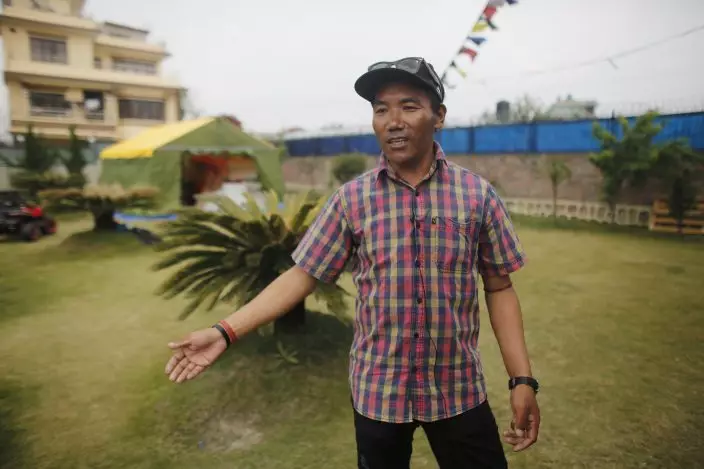
In this April 4, 2019 photo, record holding Sherpa guide Kami Rita speaks with the Associated Press in Kathmandu, Nepal. Five years after one of the deadliest disasters on Mount Everest, three people from Nepal's ethnic Sherpa community, including Rita, are preparing an ascent to raise awareness about the Nepalese mountain guides who make it possible for hundreds of foreign climbers to scale the mountain and survive. Rita, who lived through the 2014 ice avalanche on Everest’s western shoulder that killed 16 fellow Sherpa guides, aims to break his own record by reaching the mountaintop a 23rd time this spring. (AP PhotoNiranjan Shrestha)
Rita, Sherpa and Doma hail from different villages in Nepal's Himalayas, but share a goal of highlighting the bravery, sacrifice and athletic achievements of the ethnic Sherpa people, they told The Associated Press.
"In the mountains, we are all like from the same family. We spend months together at the base camp and at the same time, we are all unsure if we would return back to our family," said Rita, who survived the 2014 avalanche by staying at Everest's base camp.
Sherpa's husband, Mingma Sherpa, was part of an elite team of icefall "doctors" who are the first to fix ropes and aluminum ladders over the crevasses. In 2013, he slipped off a ladder and fell into the crevasse at the Khumbu Icefall just above base camp, long considered one of the most treacherous stages of the South Col route to Everest's summit.
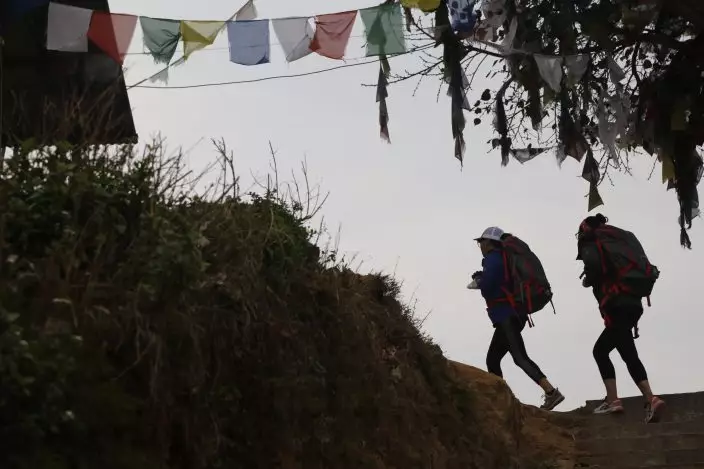
In this photo taken Saturday, March 30, 2019, Nima Doma, 34, right, and Furdiki Sherpa, 43, perform morning exercises as they train to summit Mount Everest, in Kathmandu, Nepal. Five years after one of the deadliest disasters on Mount Everest, three people from Nepal's ethnic Sherpa community, including Doma and Sherpa, are preparing an ascent to raise awareness about the Nepalese mountain guides who make it possible for hundreds of foreign climbers to scale the mountain and survive. The two women lost their husbands in the 2014 ice avalanche on Everest’s western shoulder that killed 16 fellow Sherpa guides. (AP PhotoNiranjan Shrestha)
"We want to climb Everest not just for us, but also for other women like us who have been widowed on the mountain," Furdiki Sherpa said.
The women plan to use their experience on Everest and the publicity it draws to start an organization to provide financial help, job training and counseling for other Sherpa widows.
Doma's husband, Tshering Wangchuk, died in the 2014 avalanche, crushed by a serac, a building-size chunk of ice.
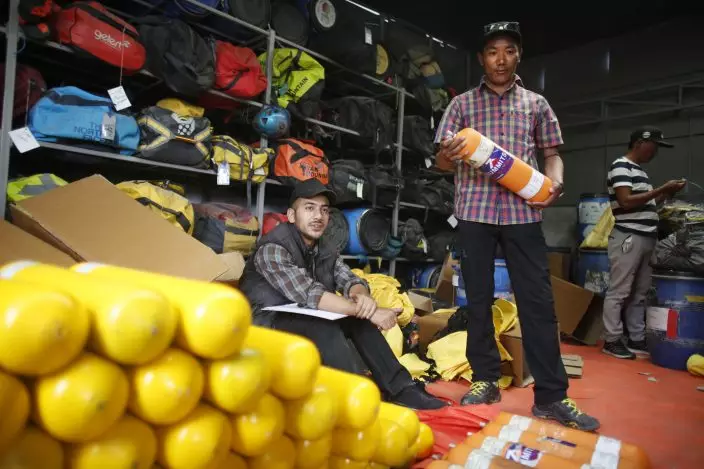
In this April 4, 2019 photo, record holding Sherpa guide Kami Rita checks oxygen cylinders and other supplies needed for climbing Mount Everest, in Kathmandu, Nepal. Five years after one of the deadliest disasters on Mount Everest, three people from Nepal's ethnic Sherpa community, including Rita, are preparing an ascent to raise awareness about the Nepalese mountain guides who make it possible for hundreds of foreign climbers to scale the mountain and survive. Rita, who lived through the 2014 ice avalanche on Everest’s western shoulder that killed 16 fellow Sherpa guides, aims to break his own record by reaching the mountaintop a 23rd time this spring. (AP PhotoNiranjan Shrestha)
Nepal's Sherpa tribespeople were mostly yak herders and traders living deep within the Himalayas until Nepal opened its borders in the 1950s after then-King Tribhuvan returned to power. Their stamina and familiarity with the mountains quickly made them sought-after guides and porters.
After her husband's death, Doma got a climbing-season job to support her children, then age 3 and 6.
"When he was alive, all I had to do was look after the household chores, but after his death I was suddenly hit with all the responsibilities," Doma said. "And then it hit me that why should we widows have to stay at home, so I started to think about climbing Everest, too, like the men."
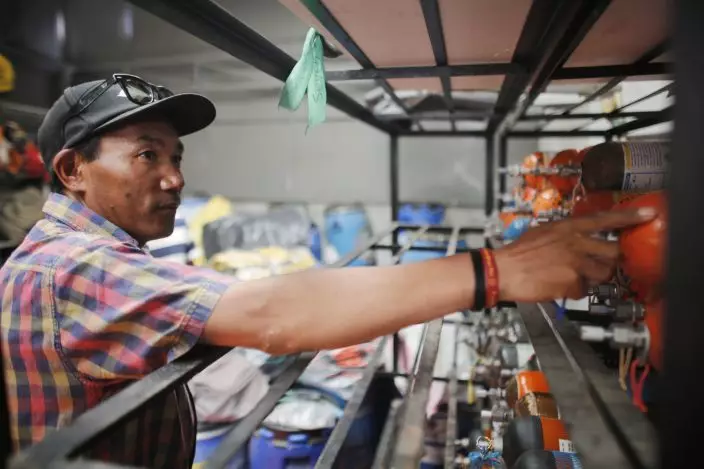
In this April 4, 2019 photo, record holding Sherpa guide Kami Rita checks oxygen cylinders and other supplies needed for climbing Mount Everest, in Kathmandu, Nepal. Five years after one of the deadliest disasters on Mount Everest, three people from Nepal's ethnic Sherpa community, including Rita, are preparing an ascent to raise awareness about the Nepalese mountain guides who make it possible for hundreds of foreign climbers to scale the mountain and survive. Rita, who lived through the 2014 ice avalanche on Everest’s western shoulder that killed 16 fellow Sherpa guides, aims to break his own record by reaching the mountaintop a 23rd time this spring. (AP PhotoNiranjan Shrestha)
While guides who help clients tackle the 8,850-meter-high (29,035-foot-high) Everest can earn up to $10,000, a king's ransom in a country where per capita income is about $1,000 a year, the high-altitude Sherpa guides have only ever been men.
After her husband's sudden death, Doma joined other women who work as porters carrying supplies to Everest's rocky base camp at 5,300 meters (17,380 feet), where climbers stay an average of six weeks to acclimatize before attempting the summit. She spent about two months away from her children.
Among the Sherpas, widows feel stigmatized and forced to stay inside their homes.
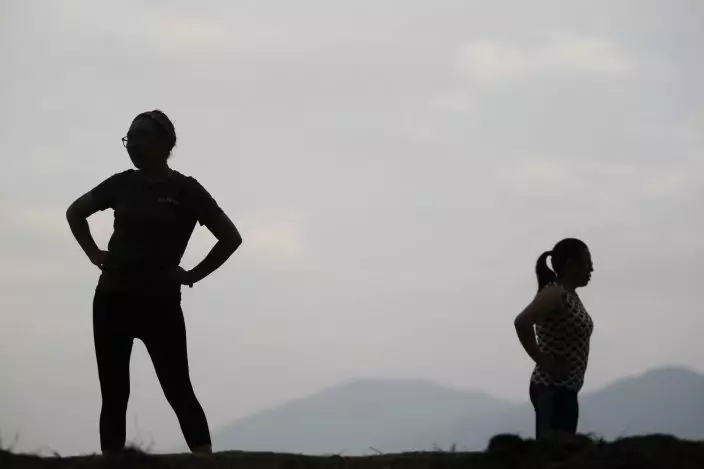
In this photo taken Saturday, March 30, 2019, Nima Doma, 34, left, and Furdiki Sherpa, 43, perform morning exercises as they train to summit Mount Everest, in Kathmandu, Nepal. Five years after one of the deadliest disasters on Mount Everest, three people from Nepal's ethnic Sherpa community, including Doma and Sherpa, are preparing an ascent to raise awareness about the Nepalese mountain guides who make it possible for hundreds of foreign climbers to scale the mountain and survive. The two women lost their husbands in the 2014 ice avalanche on Everest’s western shoulder that killed 16 fellow Sherpa guides. (AP PhotoNiranjan Shrestha)
Doma and Sherpa want to change that, and set an example that could encourage other women to pursue the lucrative work of accompanying climbers up Everest.
"They are climbing for a very good cause and it is encouraging to see women on the mountain," Rita said, though she voiced some reservations about their inexperience as mountaineers.
Rita, 49, followed his father's footsteps up Everest. His father was among the first Sherpa guides employed to help trekkers reach the summit.
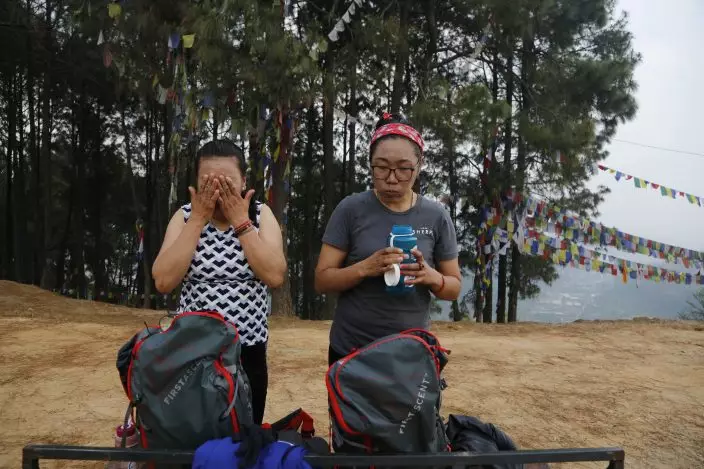
In this photo taken Saturday, March 30, 2019, Nima Doma, 34, right, and Furdiki Sherpa, 43, perform morning exercises as they train to summit Mount Everest, in Kathmandu, Nepal. Five years after one of the deadliest disasters on Mount Everest, three people from Nepal's ethnic Sherpa community, including Doma and Sherpa, are preparing an ascent to raise awareness about the Nepalese mountain guides who make it possible for hundreds of foreign climbers to scale the mountain and survive. The two women lost their husbands in the 2014 ice avalanche on Everest’s western shoulder that killed 16 fellow Sherpa guides. (AP PhotoNiranjan Shrestha)
Rita first scaled the mountain in 1994 and has been making the trip nearly every year. He has also climbed other mountains that are among the world's highest, including K-2, Cho-Oyu, Manaslu and Lhotse. He almost quit mountaineering altogether in 2016 due to family pressure.
His wife, Lakpa Jangmu, always dreads when he leaves for expeditions.
"I keep telling him we could look for other jobs, start a small business," she said. "But he does not listen to me at all."
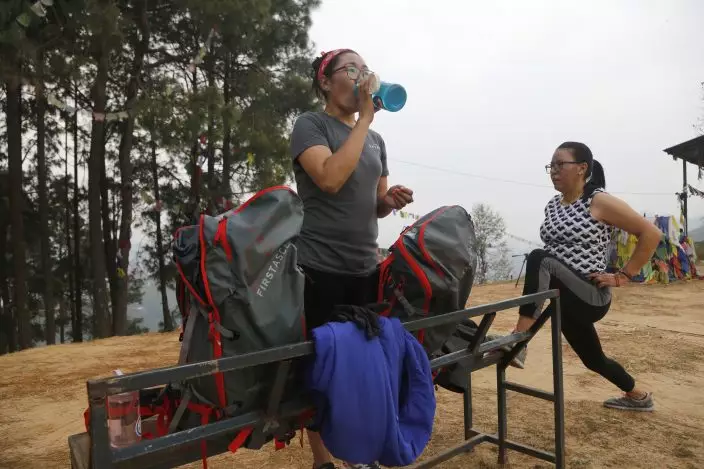
In this photo taken Saturday, March 30, 2019, Nima Doma, 34, left, and Furdiki Sherpa, 43, perform morning exercises as they train to summit Mount Everest, in Kathmandu, Nepal. Five years after one of the deadliest disasters on Mount Everest, three people from Nepal's ethnic Sherpa community, including Doma and Sherpa, are preparing an ascent to raise awareness about the Nepalese mountain guides who make it possible for hundreds of foreign climbers to scale the mountain and survive. The two women lost their husbands in the 2014 ice avalanche on Everest’s western shoulder that killed 16 fellow Sherpa guides. (AP PhotoNiranjan Shrestha)
An earthquake-triggered avalanche hit base camp in 2015, killing 19 people. Rita escaped only because his team's tents were set up that year on the camp's far side.
After the 2014 disaster, Sherpas refused to work, prompting the government to introduce new rules for better wages, increasing insurance payouts and improving rescue operations for the Sherpas.
Still, for all the Sherpas' risky and difficult work, Rita said he and others are not getting the recognition they're due.
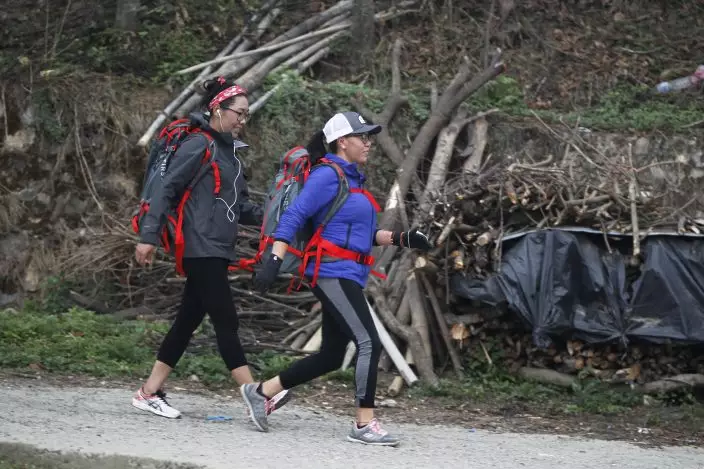
In this photo taken Saturday, March 30, 2019, Nima Doma, 34, left, and Furdiki Sherpa, 43, train to summit Mount Everest, in Kathmandu, Nepal. Five years after one of the deadliest disasters on Mount Everest, three people from Nepal's ethnic Sherpa community, including Doma and Sherpa, are preparing an ascent to raise awareness about the Nepalese mountain guides who make it possible for hundreds of foreign climbers to scale the mountain and survive. The two women lost their husbands in the 2014 ice avalanche on Everest’s western shoulder that killed 16 fellow Sherpa guides. (AP PhotoNiranjan Shrestha)
Sherpas are on the front lines, setting up the camps, carrying heavy loads on their backs, cooking food and lugging oxygen tanks. And perhaps most important, fixing ropes and ladders over crevasses and icefalls that enable mountaineers to achieve what for most is unattainable — standing on top of the world. The Sherpas are the first to reach Everest and the last to leave, Rita said.
"We are the key to mountain climbing in Nepal," he said.

In this photo taken Saturday, March 30, 2019, Furdiki Sherpa, 43, performs morning exercises as she trains to summit Mount Everest, in Kathmandu, Nepal. Five years after one of the deadliest disasters on Mount Everest, three people from Nepal's ethnic Sherpa community, including Sherpa, are preparing an ascent to raise awareness about the Nepalese mountain guides who make it possible for hundreds of foreign climbers to scale the mountain and survive. Sherpa lost her husband in the 2014 ice avalanche on Everest’s western shoulder that killed 16 fellow Sherpa guides. (AP PhotoNiranjan Shrestha)






